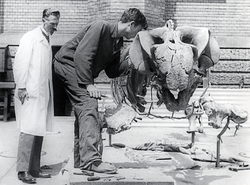Friedrich von Huene
Friedrich von Huene, tam adı Friedrich Richard von Hoinigen (22 Mart 1875 - 4 Nisan 1969), 20. yüzyılın başlarında Avrupa'daki herkesten daha fazla dinozorun adını değiştiren bir Alman paleontologdu. Ayrıca çeşitli Permo-Karbonifer dört üyeli omurgalıları hakkında önemli katkılarda bulundu.
Friedrich Richard von Hoinigen | |
|---|---|
 Tübingen Üniversitesi'nde bir Stahleckeria (disinodont) iskeleti ile Friedrich von Huene (solda), 1935. | |
| Doğum | 22 Mart 1875 Tübingen |
| Ölüm | 4 Nisan 1969 (94 yaşında) Tübingen |
| Milliyet | Alman |
| Kariyeri | |
| Dalı | Paleontoloji |
Biyografi
değiştirHuene, Württemberg Krallığı, Tübingen'de doğdu. Buluşları arasında ünlü Trossingen ocağındaki 35'ten fazla Plateosaurus bireyinin, 1910'da erken proto-dinozor Saltopus'un, 1926'da Proceratosaurus'un, 1929'da dev Antarctosaurus'un ve çok sayıda diğer dinozor ve teruzorlar gibi fosilleşmiş hayvanların iskeletleri yer alıyor. Ayrıca, Prosauropoda ve Sauropodomorpha da dahil olmak üzere birkaç yüksek taksonu adlandıran ilk kişi oldu.
1928'de Paleorrota Jeoparkını ziyaret etti ve 1938'de Prestosuchus chiniquensis'i orada topladı.
Ayrıca Temnospondyli, Synapsida ve Sauropsida gibi birkaç büyük dalın üyeleri de dahil olmak üzere birkaç Permo-Karbonifer ve Triyas uzuvlu omurgalıları üzerinde çalıştı. Mesosaurlar üzerine yaptığı çalışmada Huene, daha düşük bir temporal fenestranın mevcut olduğunu belirtti (sinapsidlerde olduğu gibi); bu yorum daha sonraki birçok araştırmacı tarafından reddedildi, ancak daha yakın zamanda desteklendi.[1][2][3][4][5][6][6][7][8][9]
Yeni bir bazal sauropodomorf türü, Lufengosaurus huenei, 1941'de von Huene için adlandırıldı. Erken etçil bir teropod olan Liassaurus huenei, adı geçersiz olmasına rağmen, 1995 yılında onun için seçildi.
Ayrıca bakınız
değiştirKaynakça
değiştir- ^ Huene (1910). "Neubeschreibung des permischen Stegocephalen Dasyceps bucklandi (Lloyd) aus Kenilworth". Geologische und Paleontologische Abhandlungen. 8: 325-338.
- ^ Huene (1905). "Pelycosaurier im deutschen Muschelkalk". Neues Jahrbuch für Mineralogie, Geologie und Paläontologie. 20: 321-353.
- ^ Huene (1908). "Neue und verkannte Pelycosaurier-Reste aus Europa". Centralblatt für Mineralogie, Geologie und Paläontologie. 14: 431-434.
- ^ Huene (1925). "Ein neuer Pelycosaurier aus der unteren Permformation Sachsens". Geologische und Paleontologische Abhandlungen. 18 (Neu Folge 14): 215-264.
- ^ Huene (1912). "Die Cotylosaurier der Trias". Palaeontographica Abteilung A. 59: 69-102.
- ^ a b Huene (1940). "Osteologie und systematische Stellung von Mesosaurus". Palaeontographica Abteilung A. 92: 45-58.
- ^ Modesto (1999). "Observations of the structure of the Early Permian reptile Stereosternum tumidum Cope". Palaeontologia Africana. 35: 7-19.
- ^ Rossmann (1999). "Das Mesosaurier-Material in der Bayerischen Staatssammlung für Paläontologie und Historische Geologie: Übersicht und neue Erkenntnisse". Mitteilungen der Bayerischen Staatssammlung für Paläontologie und historische Geologie. 39: 69-83.
- ^ Piñeiro (2012). "Cranial morphology of the Early Permian mesosaurid Mesosaurus tenuidens and the evolution of the lower temporal fenestration reassessed". Comptes Rendus Palevol. 11 (5): 379-391. doi:10.1016/j.crpv.2012.02.001.